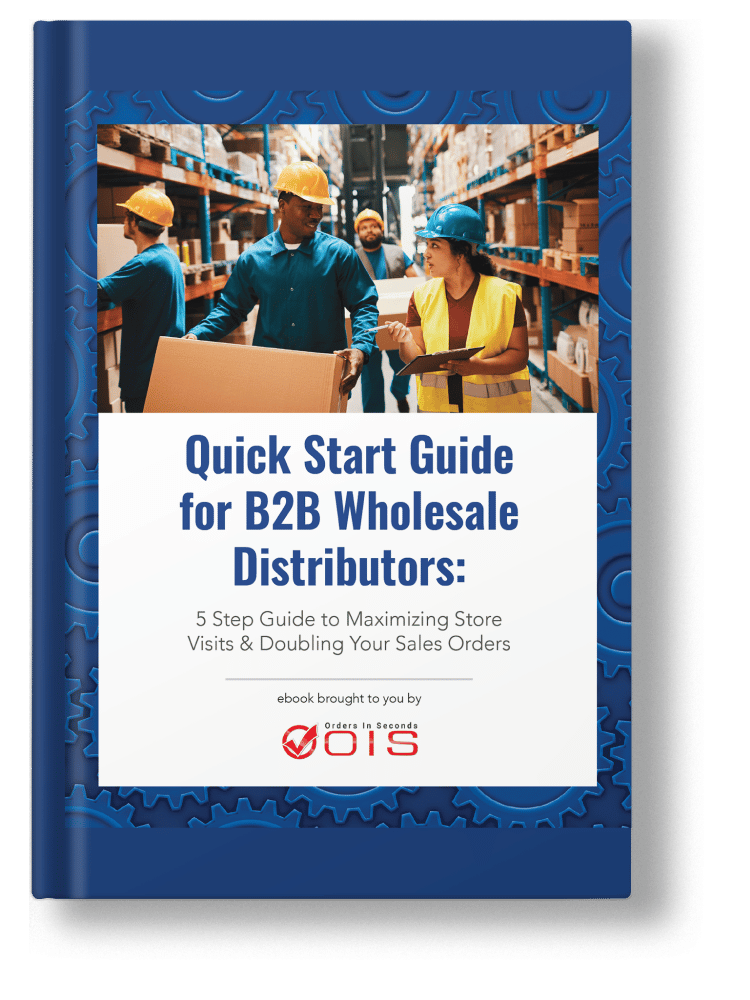Direct Store Delivery (DSD) has advantages over centralized distribution for many wholesalers. While centralized distribution is effective for products that are simple to transport, don’t need special handling, and have a long shelf life, direct store delivery is appropriate for all products and delivers products swiftly and directly to customers. The logistics industry benefits greatly from the efficiency and speed of direct store delivery.
Direct Store Delivery does, however, come with certain difficulties. To ensure that your field crew doesn’t lose out on last-minute retail possibilities, you must first keep them productive, organized, and informed on the newest sales and product information.
This article will define direct store delivery, discuss its advantages, and explain how Orders in Seconds can support your company’s implementation of direct store delivery through its B2B channels.
What is Direct Store Delivery? and what does DSD mean?
Direct store delivery (DSD) means delivering goods directly to a store from a supplier or distributor rather than through the retailer’s distribution center. DSD also tends to give distributors rather than shops control over product unloading and stocking. DSD distribution is a crucial channel in the grocery sector since it not only expedites the delivery of produce with limited shelf life, but also enhances supply chain visibility and gives retailers control over display space.
Retailers who sell perishable goods and have constrained delivery windows for their products benefit from direct store deliveries. This approach is primarily appropriate for pharmacies, convenience stores, gas stations, soft drink and beverage producers, and businesses that produce organic foods.

The Importance of Direct Store Delivery: Enhancing Efficiency and Customer Satisfaction
Direct Store Delivery (DSD) holds immense importance in the modern business landscape, offering significant benefits for manufacturers, retailers, and consumers alike. By shortening the supply chain, DSD enhances operational efficiency, minimizes inventory holding costs, and reduces the risk of product damage or spoilage. Additionally, the distribution process in DSD streamlines various stages like inbound operations and shipping, ensuring freshness, quality, and adherence to brand standards while reducing waste. Route optimization plays a crucial role in ensuring that DSD operations are efficient and cost-effective.
For retailers, DSD means faster restocking, reduced inventory management tasks, and increased product availability. Ultimately, DSD benefits consumers by providing access to a diverse range of fresh products and eliminating delays associated with traditional distribution processes. By embracing direct store delivery, businesses can optimize efficiency, improve customer satisfaction, and gain a competitive advantage in today’s dynamic retail landscape.
What does DSD mean in Retail?
DSD retail is a method of product distribution where a supplier delivers goods directly to a retail store instead of going through a distribution center. With DSD, the supplier is responsible for managing inventory levels, restocking shelves, and ensuring that the products are displayed properly in the store. This method allows for a more efficient supply chain since it eliminates the need for multiple shipments and improves delivery performance. DSD is commonly used for perishable goods such as dairy, bakery, and snack items, as well as non-perishable items like beverages and magazines. Retailers benefit from DSD as it helps to reduce their inventory holding costs, improves product freshness, and allows them to offer a wider variety of products to their customers.
Direct Store Delivery vs. Distribution Centers
Retailers can buy products directly from suppliers thanks to the DSD approach. Almost all tasks in the supply chain are completed by the supplier, including:
Checking the stock
Ordering supplies
Unpacking pallets
Assigning shelf space
Elimination of stale or expired stock
Setting up advertising displays
Pricing display
The DSD model also enables manufacturers to ship their goods directly to the retailer or location using a DSD distributor. In comparison to the conventional Centralized Distribution paradigm, this one is very different.
The supplier sends inventory to a central location in the centralized system. In a warehouse or distribution center, products are kept. The products are transported to the retailer from the warehouse after the merchant places an order for them.
The entire burden of responsibility in the centralized distribution model falls on retailers. In the case of a DSD model, the manufacturer is in charge. Organizations can benefit from DSD by streamlining logistics and optimizing routes for immediate delivery to retail locations, ultimately enhancing efficiency and reducing product wastage. Effective fleet management is essential to ensure timely and accurate deliveries in the DSD model.
Direct Store Delivery Companies: What You Need to Know
Direct Store Delivery (DSD) companies are businesses that specialize in the delivery of goods directly to retail stores. DSD companies are typically involved in the distribution of perishable goods, such as food and beverages. They operate in a highly specialized niche of the logistics industry, with a focus on providing fast and efficient delivery services to retailers. Some of the biggest names in the DSD industry include Coca-Cola, PepsiCo, and Frito-Lay. These companies must adhere to strict delivery schedules to ensure timely and efficient service.
exclusive distribution
Navigating Efficiency: The Art of DSD Route Distribution
Direct Store Delivery (DSD) route distribution has emerged as a pivotal strategy for optimizing the delivery of goods from manufacturers to retail outlets. This approach focuses on crafting efficient routes that minimize travel time and maximize the number of stops per trip. With the aid of advanced route optimization software and real-time tracking, DSD route distribution ensures that products reach their destinations swiftly and accurately. This not only reduces transportation costs but also enhances inventory management by allowing businesses to replenish stock just in time, reducing storage needs and wastage. Furthermore, DSD route distribution fosters closer relationships between manufacturers and retailers, facilitating direct communication and collaboration. As businesses continue to seek ways to enhance supply chain efficiency, DSD route distribution stands as a key strategy that promises streamlined operations and improved customer experiences.
DSD Meaning in Logistics
DSD, or Direct Store Delivery, is a logistics method where manufacturers or suppliers deliver products directly to retail stores, bypassing distribution centers. This approach streamlines the supply chain, reducing handling and ensuring fresher products on store shelves.
DSD Grocery Meaning
DSD in the grocery industry stands for Direct Store Delivery. It involves food and beverage suppliers delivering their products straight to supermarkets, ensuring a constant flow of fresh and in-demand items, leading to better stock management.
DSD CPG – Consumer Packaged Goods
DSD (Direct Store Delivery) is a crucial distribution strategy for the Consumer Packaged Goods (CPG) industry. It allows CPG companies to maintain control over product quality and placement in retail stores, making it a vital aspect of their supply chain operations.
Bitperfect Hybrid DSD Files
Bitperfect Hybrid DSD files represent high-resolution audio formats with uncompromised sound quality. These files are optimized for audiophiles, delivering audio that’s as close to the original recording as possible, making them prized assets for high-end music enthusiasts.
Music Files Encoded in DSD Format
Music files encoded in DSD format offer exceptional audio fidelity. DSD, or Direct Stream Digital, uses a different approach to digital audio encoding, resulting in a purer and more accurate representation of sound. Audiophiles often prefer DSD for its ability to preserve the nuances of live recordings.
DSD Format: Unraveling the Audio Quality
Direct Store Delivery (DSD) companies are businesses that specialize in the delivery of goods directly to retail stores. DSD companies are typically involved in the distribution of perishable goods, such as food and beverages. They operate in a highly specialized niche of the logistics industry, with a focus on providing fast and efficient delivery services to retailers. Some of the biggest names in the DSD industry include Coca-Cola, PepsiCo, and Frito-Lay.
What are the Main Benefits of Direct Store Delivery?
Direct store deliveries are becoming more and more common. Many businesses in the dairy, pastry, and beverage sectors already run some type of direct store delivery operation. Improved inventory turnover is another significant benefit of the DSD model. Let’s examine the main advantages of DSD in the grocery store industry.
Efficient handling of perishable and fragile items
The DSD model works well for perishable goods that must be handled carefully and quickly, such as fruits, vegetables, poultry, flowers, and bakery products. Wafers, potato chips, and biscuits are examples of fragile commodities that require particular handling during packaging and delivery.
DSD shortens the time things spend in the supply chain, extending the shelf life of perishable and fragile goods by adhering to strict delivery windows. In the food, beverage, and grocery industries, where there is less chance of damage to these products, DSD channels are the most widely used.
Faster deliveries to retail stores
DSD gets rid of distribution hubs and warehouses. It arrives at stores quicker and cuts down on the whole time on the market dramatically. Less transit time is required for consumer goods to guarantee a high level of product availability.
The ability to consistently maintain an adequate quantity of product is also beneficial to the store owners.
In today’s fast-paced market, the ability to ensure faster deliveries to retail stores is a critical competitive advantage for businesses across various sectors. Efficient logistics and streamlined supply chains directly impact product availability on shelves and ultimately contribute to customer satisfaction and sales. For companies aiming to optimize their delivery networks and expand their market reach, having a well-defined list of retail stores is an essential starting point. This enables businesses to strategically plan delivery routes, identify key distribution points, and ensure timely replenishment of stock.
Reduced labor and logistics expenses
Consumer goods are neither transported to nor kept in a warehouse or distribution facility when they are delivered directly to the store. Because you don’t have to pay for transportation costs (such as gas or driver compensation) or for renting, maintaining, or staffing a warehouse, this lowers your logistics costs and enhances operational efficiency.
As a result, it lowers the costs associated with logistics and overall transportation expenditures, including store labor costs. The DSD approach saves 25% of labor expenditures on average.
Increased customer satisfaction
Putting the needs of the customer first is an effective business strategy. Customers are less likely to face stockouts at retail establishments with quicker and appropriate stocking.
Customers are more satisfied as a result of the quicker access to the requested products. This leads to an improved customer experience and a customer base that is more loyal. Customer feedback is crucial in ensuring that the DSD model meets consumer expectations.
Enhanced customer relationships
Through this delivery technique, a brand can establish better relationships with retailers and end users.
For instance, when brands sell products to retailers, it enables them to gain market insights about things like what products customers are buying more of, current market and trend information, as well as which products are underperforming. By providing this information, the brand or company can communicate more easily.
Additionally, they learn how to market and strategize efficiently while placing a high premium on providing improved customer service. Consequently, a fruitful brand-retailer association is created.
What are the Challenges of Direct Store Delivery?
Here are some of the major challenges of the DSD model.
Therefore, a supply chain visibility solution is absolutely necessary to help the suppliers with this problem.
Higher cost of transportation
When a company uses DSD, the supplier is responsible for managing the goods’ end-to-end shipping and transportation.
The cost of transportation cannot be ignored, despite the fact that it is still faster and more transparent. Although the supply chain as a whole is known for eliminating warehouses and lowering labor expenses, the operating costs are still significant.
Unexpected changes in the course of shipping
It can be challenging for businesses using this approach for the first time to accept real-time order requests or adjustments to delivery timetables. It is necessary to improve operational efficiency because the market has grown more complicated and competitive.
Finding prospective sources of business revenue is tough due to the rigid supply chain. Therefore, tools that promote openness, ease, responsiveness, and adaptability are thus necessary.
Inadequate communication
It is difficult to establish a connection between the brands (suppliers), employees of the distribution center, and the retailer. Similar to the lack of cooperation about delivery status, product inventory, and price fluctuations, improper communication can also contribute to these issues. This will have a significant effect on the company’s profit margin.
Fleet management and monitoring challenges
For retail distribution, managing and keeping an eye on fleets traveling in several directions becomes challenging. They are accountable for making sure the deliveries arrive at the retail locations within the specified time frames and without any delays. They must also guarantee that delivery personnel carry out their tasks effectively.
Additionally, it might occasionally be inaccurate to manually coordinate with the workers on the ground and record delivery information. Therefore, a supply chain visibility solution is absolutely necessary to help the suppliers with this problem.
Work on the issues and make an effort to fix them if you want DSD to succeed.
Direct Store Delivery Best Practices
You must keep in mind that a DSD model is not a one-size-fits-all strategy if you wish to make the switch. You will need to make a number of adjustments and execute a number of crucial actions. They consist of the following:
Best Practice 1: Configure omnichannel visibility
It’s critical to coordinate order administration, fulfillment & shipping, and inventory management in one location to raise and maintain direct retail delivery standards and enhance supply chain visibility. Additionally, it should be necessary to gather information about every retail store from every sales channel.
The omnichannel visibility will make it easier to keep track of inventories in all of the retail locations. Finding data on inventory turnover and average sales for each retail location as well as all of them will be made easier with this. All of this data will gradually assist in identifying the areas where sales growth can be improved.
Best Practice 2: Plan efficient routes
To satisfy customer demands, you should create routes that are properly optimized through route optimization. Consequently, a delivery route planner should be used.
You may create a route with numerous stops using the greatest route planners, such as Order in Seconds. The route sales software lets you know:
How to transport more goods using fewer vehicles
How many routes you should designate for each vehicle and driver, given the carrying and loading capacities of your vehicles
The order that will cost-effectively visit and service all of your retailers
How to minimize waiting times by taking your shops’ availability time slots into account
How to adhere to your state’s DSD regulations
The DSD software from supports the import of thousands of store addresses. Additionally, it will automatically produce the best possible sequence of routes for each of the available drivers.
Best Practice 3: Track SKUs effectively
The need for the manufacturer to keep track of thousands of different Stock Keeping Units (SKUs) is one of the difficulties with the Direct Store Delivery model. However, this figure is always fluctuating.
The route planner tool from Orders in Seconds lets you add and match up numerous barcodes at every route address. You may follow all delivery SKUs with the help of our mobile barcode reconciliation capability without the need for additional mobile sales software or pricey barcode scanners.
Best Practice 4: Enhance your customer service
Customer satisfaction and feedback are crucial components of every organization. By including a customer feedback system into the process, customer service can be improved. This will guarantee that direct store delivery is successfully completed and that customers receive their items.
Best Practice 5: Make sure your team has information to support them.
Every procedure for the warehouse or retailer’s distribution center needs to be made more efficient. Even in a supply chain management system, information loss is a possibility. Therefore, direct store delivery software can be used to prevent any misunderstandings or errors between DSD suppliers and retail establishments, acting as a supply chain visibility solution. This will maintain all of the parties’ current and updated data.
Best Practice 6: Focus on inventory control
The brands are solely in charge of distributing the products to retail outlets and consumer markets under the DSD method, making inventory turnover a critical aspect to manage. Therefore, it is crucial to manage the delivery fleet properly through planning and management. This will contribute to the delivery process being more efficient and streamlined.
Managing a delivery fleet may include information like how many vehicles are owned vs rented, how to deploy them for quicker delivery, and how to monitor these vehicles once they are on the road.
OIS can assist you in running efficient delivery operations by assisting with inventory management and delivery route planning. Find out how we can become your go-to tool for making multi-stop deliveries.
How OIS Direct Store Delivery Software Can Help Boost Your Delivery Performance
Orders in Seconds (OIS) is a simplified and easy-to-use direct store delivery software and and a solution for delivery route planning and optimization. Among its key features are automated route planning, route scheduling, delivery alerts, and proof of delivery.
You can utilize OIS as a direct store delivery driver to make on-time deliveries by taking the quicker routes. You may generate efficient routes for your hundreds or thousands of delivery routes with the aid of the route planner. OIS also enables you to save total transportation expenses and boost corporate revenues.









